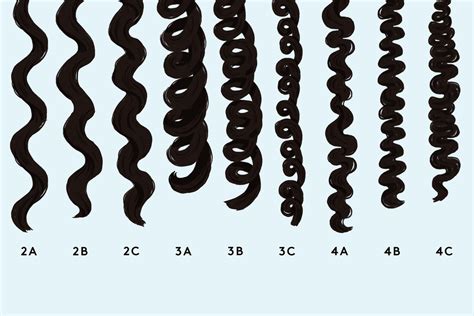The Allure of Curls
Curls, with their mesmerizing coils and infinite variations, have captivated hearts and heads for centuries. Whether you’re embracing your natural ringlets or seeking to enhance them, understanding the different types of curly hair is essential for creating a customized hair care routine.

The Curly Hair Classification System
The André Walker Hair Typing System, developed by renowned hairstylist and Oprah Winfrey’s personal hair guru, categorizes curly hair into four distinct types, based on its texture and curl pattern:
1. Type 2: Wavy Hair
- Key Features: Loose, S-shaped waves that may appear straight when dry.
-
Subtypes:
- 2A: S-waves are loose and visible.
- 2B: S-waves are more defined but still flow smoothly.
- 2C: S-waves are tighter and can have a slight zigzag pattern.
- Benefits: Wavy hair is generally easy to manage, with curls that are defined yet maintain a natural flow.
2. Type 3: Curly Hair
- Key Features: Defined curls that form a spiral or corkscrew pattern.
-
Subtypes:
- 3A: Loose, springy curls that are about the size of a pencil.
- 3B: Medium-sized curls that are about the size of a Sharpie marker.
- 3C: Tight, corkscrew curls that are about the size of a soda straw.
- Motivation: Curly hair often requires more moisture and curl-defining products to maintain its shape and prevent frizz.
3. Type 4: Coily Hair
- Key Features: Small, tightly coiled curls that resemble a zigzag pattern or a spring.
-
Subtypes:
- 4A: Coils are S-shaped and have a well-defined pattern.
- 4B: Coils are more tightly coiled and have a Z-shaped pattern.
- 4C: Coils are extremely tight and may resemble a cotton ball.
- Pain Points: Coily hair can be prone to dryness, tangles, and breakage. It typically requires extra hydration and gentle handling.
Curls Across the Globe
According to a study conducted by the Global Beauty Collective, over 60% of the world’s population has curly hair.
1. Type 2: Wavy Hair
- 2A: Common in Eastern Europe, Africa, and South America.
- 2B: Frequently seen in the Middle East and Asia.
- 2C: Prevalent in North America, especially among people of mixed ancestry.
2. Type 3: Curly Hair
- 3A: Found across all continents, but particularly common in Western Europe and North America.
- 3B: Predominant in South Asia, the Caribbean, and some parts of Africa.
- 3C: Most prevalent in parts of Africa and the African diaspora.
3. Type 4: Coily Hair
- 4A: Common in West and Central Africa, as well as the African diaspora.
- 4B: Predominant in Eastern and Southern Africa.
- 4C: Highly concentrated in West and Central Africa.
Embracing Your Curls
Embracing your natural curls is a journey of self-discovery and self-expression. By understanding the different types of curly hair, you can tailor your hair care routine to suit your unique needs:
- Hydration: All types of curly hair benefit from ample hydration to prevent dryness and frizz.
- Curl Definition: Curl-defining products, such as gels, creams, and mousses, can enhance the shape and definition of curls.
- Detangling: Regular detangling with a wide-toothed comb or brush helps prevent tangles and breakage.
- Gentle Styling: Curly hair is more prone to damage from heat and rough handling. Use heat sparingly and opt for gentle styling techniques.
Tips and Tricks for Healthy Curls
- Co-wash: Cowashing (washing your hair with conditioner instead of shampoo) can help prevent dryness and maintain moisture.
- Wide-toothed Comb: Use a wide-toothed comb or brush to detangle hair gently, minimizing breakage.
- Oil Treatments: Regular oil treatments, such as coconut oil or argan oil, can deeply nourish and protect curls.
- Protective Styles: Braids, buns, and headwraps can protect curls from damage and reduce tangles.
Conclusion
The world of curly hair is a diverse and vibrant tapestry. By understanding the different types of curly hair and embracing its unique characteristics, you can unlock the full potential of your ringlets and unleash the beauty that lies within.
